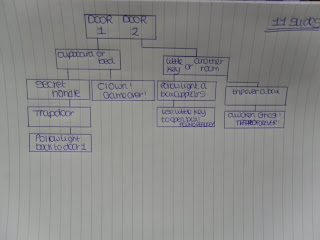Evaluation of Interactive Narrative
Looking back at the brief, I have produced an interactive narrative using still images, which i have put onto a timeline in Flash CS3 ActionScript 3.0, which much consist of 10 still images. This then gives the audience a choice of decisions as they go through the interactive narrative. I began doing this by drawing out plans of ideas and to see where they could take me, to see what choices I had for my audience and to see what each slide would look like. I found flash very hard as I had only used it the odd once before and it was a few years ago! I used the original template that was on the program already to start me off! This included buttons which at the time I did not know how to make. I made my interactive narrative to be aimed at the younger generation, if i had more time and i had a chance to go over this project again, I may have had more options that were maybe more exciting. I managed to add audio and made some of my buttons change colour when you hover over them which I feel has made my piece a lot more fun and interesting to play. I have also made some of my images move so it feels like you are actually going somewhere. On the whole this was a very stressful piece, however looking back at it now I enjoyed it!
Find the way out by ~CCochrane on deviantART




